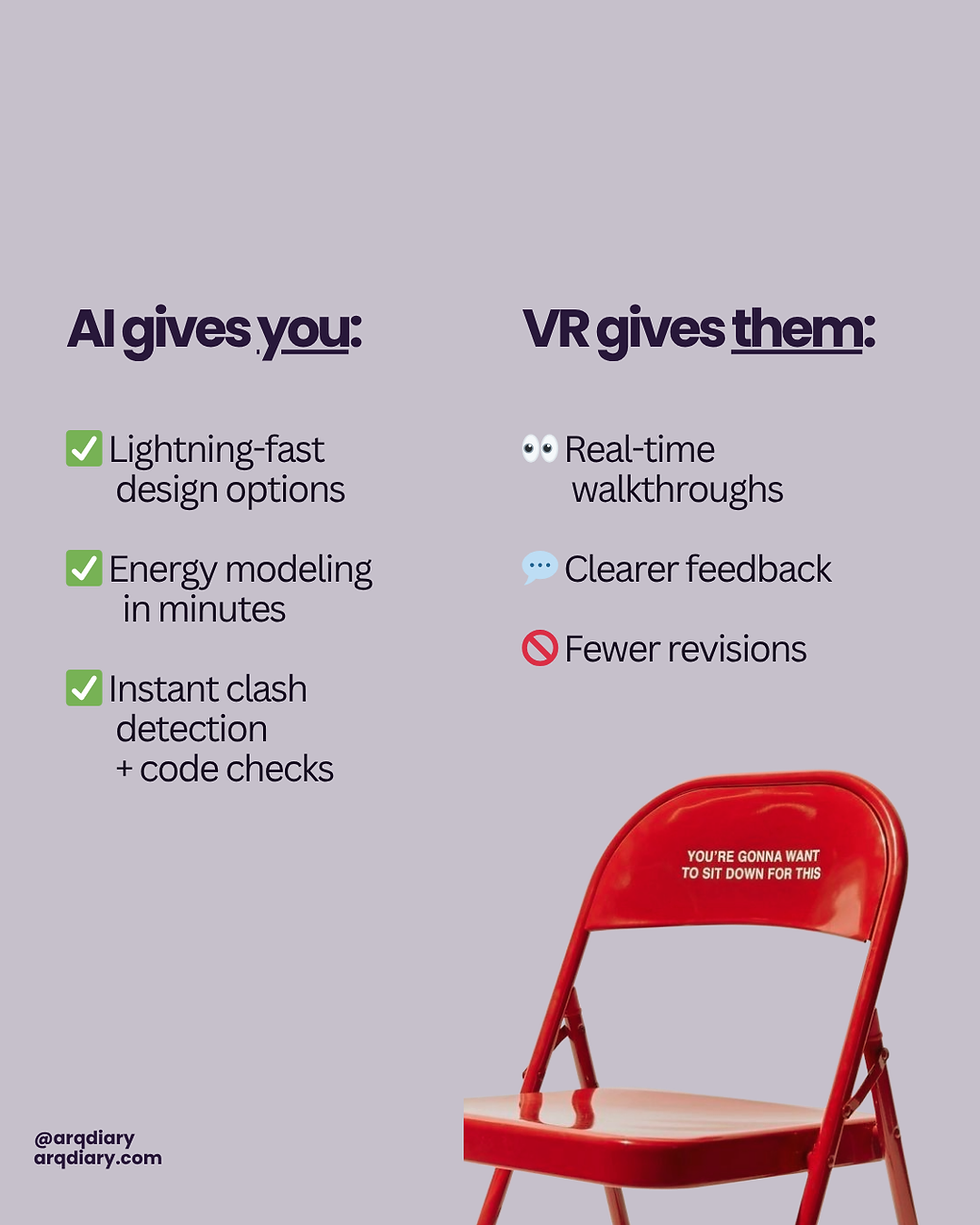AI + VR Are Taking Over Architecture: Why You Can’t Afford to Ignore Them
- arqdiary

- Aug 5
- 4 min read
Picture this: a few months ago, I was wading through a jungle of floor plans, site studies, and client revisions like a lost explorer. My routine? Sketch, erase, tweak, rinse and repeat—sometimes for days. I thought I was living the architect life.
Then—WHAM! AI-powered software swooped in and, no kidding, turned my week-long marathon into a 24-hour relay for the whole team. And VR? Clients were strolling through their future offices by day two of the design phase.
I thought I was ahead of the curve... but really, I was just playing catch-up. If you’re still snoozing on AI and VR, consider this your wake-up call. Here’s why these tech wonders aren’t just shiny new toys—they’re the future of how architects work, design, and land gigs.

Why AI Is More Than Just a Fancy Render Tool
AI goes beyond merely enhancing your renderings; it is fundamentally transforming every aspect of the architectural and design process, stretching from the initial stages of concept development all the way through to comprehensive project management.
Speed: AI tools generate multiple design options in minutes. Need 10 facade concepts? Done. Want to optimize your building’s energy use? AI processes the data faster than any human could.
Creativity Boost: Feeling stuck in a design rut? AI provides fresh perspectives by analyzing numerous precedent projects or creating novel forms based on your input.
Precision: Enjoy automated clash detection, code compliance checks, and even cost estimations—all in real time.
In essence, AI takes care of the heavy lifting, allowing architects to concentrate on the visionary aspects.
VR: Your Client’s New Favorite Playground
Remember when we used to send clients static renderings and hope they could “imagine” the space? Yeah, that’s ancient history.
VR lets clients experience your design before a single brick is laid. Want to know how natural light will move through the space at 3 PM? Strap on a headset and walk through it.
This means fewer revisions, clearer communication, and happier clients. It also means architects who master VR stand out in a sea of spreadsheets and 2D plans.
Here’s What’s Changing on the Job Site
AI and VR are transforming construction by enhancing project planning, execution, and management. These technologies improve efficiency, safety, and outcomes.
AI-driven drones monitor site progress, using advanced algorithms to analyze construction sites in real time. They quickly identify issues like structural anomalies and safety hazards, enabling immediate action. This speeds up inspections and reduces costly delays and rework.
VR and AR allow teams to overlay 3D models onto real environments, enabling visualization before construction begins. This helps identify errors early, improving collaboration and reducing costly mistakes. Spotting issues beforehand fosters efficient workflows and alignment with the original vision.
This reduces costly mistakes and delays. Architects who know this tech aren’t just designers—they’re the linchpins of smarter, faster builds.

The Reality Check
If you’re thinking, “I’m just a student” or “I’ll learn this stuff later,” here’s the truth:
By the time you get comfortable with old-school methods, firms are already hiring architects who can harness AI and VR to save time and wow clients.
It’s like refusing to learn CAD back in the early 2000s—except the gap is even bigger now. The good news? Getting started is way easier than you think.
How to Get Ahead: Your Starter Pack
You don’t have to become a tech wizard overnight. Start small:
Play with AI sketch generators like Midjourney or DALL·E to spark new and exciting ideas! These tools can unleash your creativity and help you visualize concepts you may not have thought possible. Dive in and see what incredible designs you can create!
Take VR tours of iconic buildings on platforms like IrisVR or Autodesk’s Forge! Immerse yourself in stunning architectural masterpieces from around the globe. Experience the grandeur and details of these structures as if you were actually there—it's an exhilarating way to learn and gather inspiration!
Learn Revit plugins that use AI for clash detection or automation (hello, Dynamo!). Mastering these tools can significantly enhance your workflow and efficiency. Embrace the future of design by leveraging AI to streamline your processes and focus on what truly matters—your creativity!
Experiment with Enscape 2025—its AI-powered rendering features are next-level! Get ready to elevate your visual presentations to breathtaking heights. With stunning realism and quick rendering times, you’ll be amazed at how this technology can transform your projects and captivate your audience!
Join online communities (Discord, Reddit) where architects share tips on AI and VR! Connect with like-minded professionals and enthusiasts who are just as passionate about innovation in architecture. Exchange ideas, seek advice, and stay updated on the latest trends—it's a fantastic way to grow and thrive in your field!

Final Thought: Your Future Firm Wants This
Imagine walking into your next interview and confidently saying, “I use AI to generate efficient design options and VR to create immersive client presentations.” How cool would that be? It’s like stepping into the future with a toolbelt full of cutting-edge technology!
That’s not sci-fi. That’s right now, and it’s absolutely thrilling!
This tech isn’t here to replace architects—oh no! It’s here to make us smarter, faster, and way more creative than ever before. Think of it as your secret weapon in the design world! The architects who embrace it today are not just keeping up; they are the trailblazers and leaders of tomorrow, shaping the industry in ways we can only dream of. So, let’s dive into this exciting wave of innovation and see where it takes us!



Comments